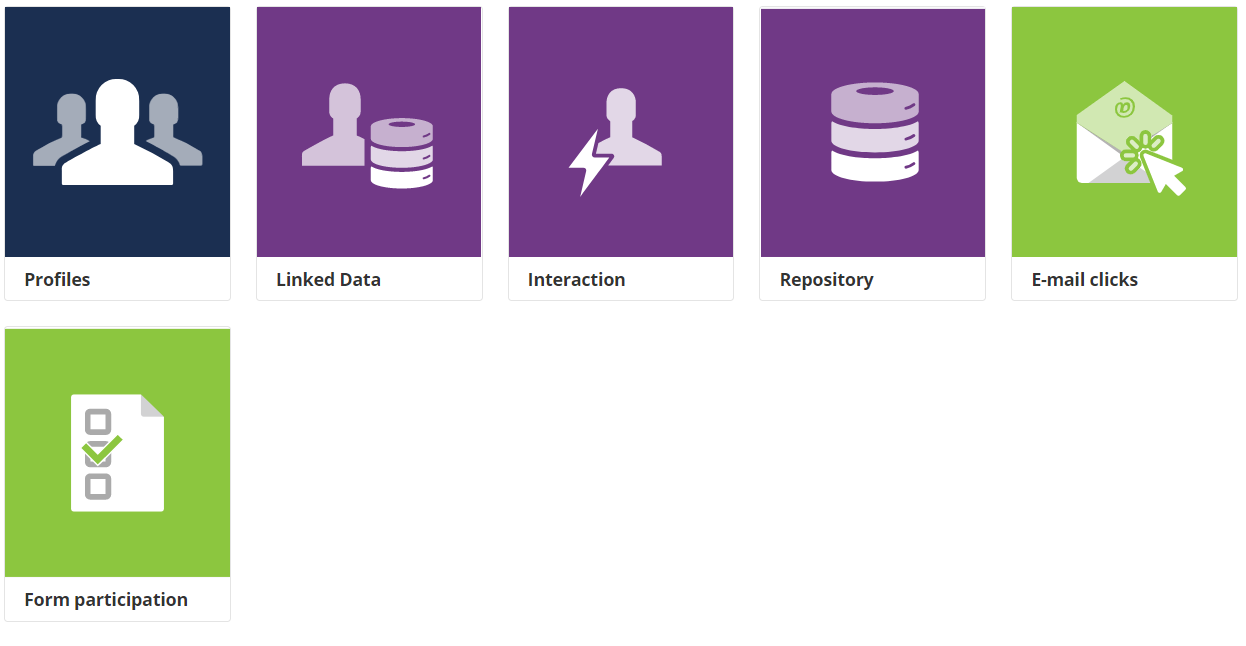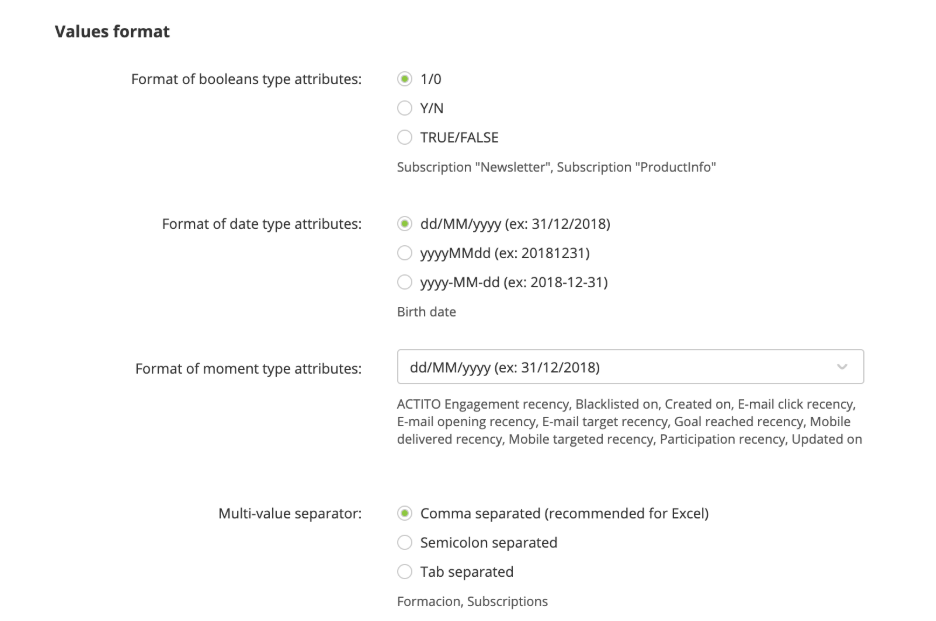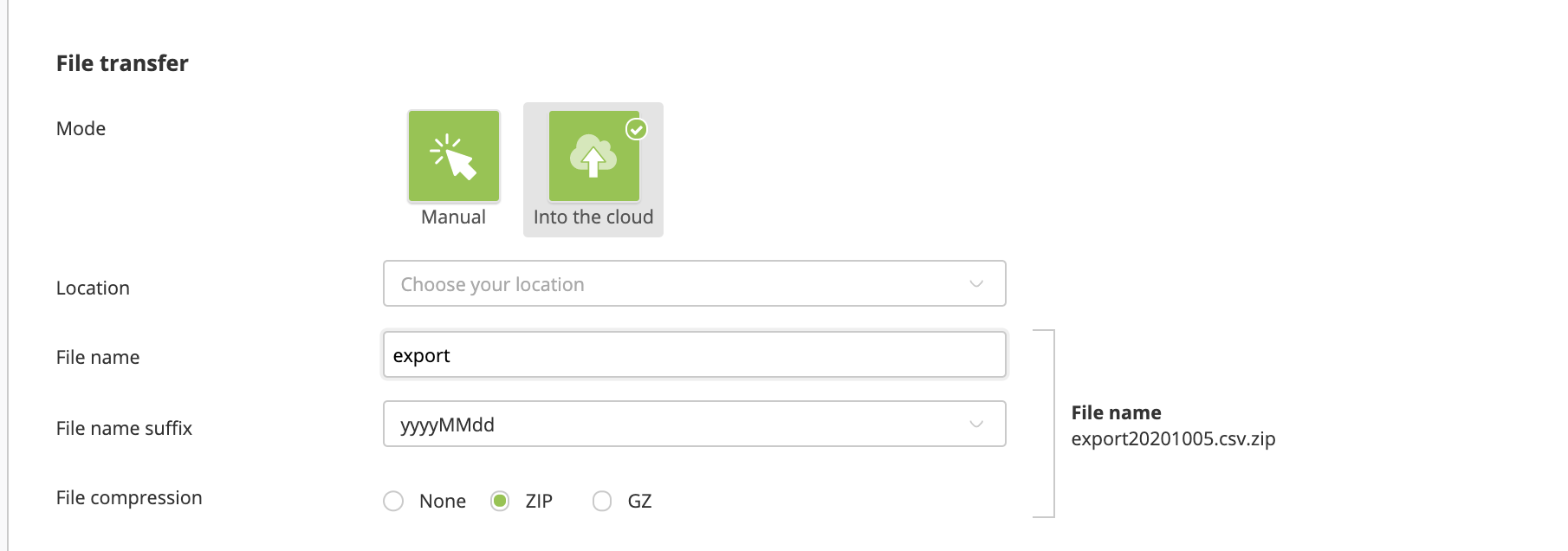Creating One-Shot exports
One-shot exports are manual exports that only occur once.
They are perfect to retrieve data that you want to analyze or use right now, but that you do not need to compare over a long period of time.
The different types of one-shot exports
You can create 6 different types of one-shot exports :
-
Profile exports : Can be used to export data from all the attributes of a profile table, including subscriptions and segmentations. These exports cannot contain data Custom Tables.
-
Interactions exports : Can be used to exports data from all the fields of the Interaction table (including several lines at once for the same profile), plus all the profile table data (attributes, subscriptions and segmentations) from the corresponding profile (The entries in an Interaction Custom table are always linked to a single profile)
-
Linked Data exports : Can be used to exports data from all the fields of the Linked Data table (including several lines at once for the same profile), plus all the profile table data (attributes, subscriptions and segmentations) from the corresponding profile (The entries in a Linked Data Custom table are always linked to a single profile)
-
Repository exports : Can only export data from all the fields of the Repository table, without any data from profiles (The entries in a Repository table are not directly linked to profiles. )
-
E-mail clicks exports : Can be used to export all the clicks interactions (ex. : clicked URL, click moment, ...) recorded on one specific e-mail campaign.
-
Form participations exports : Can be used to export the participations to one specific form (form parameters and answers to the questions).

Thanks to the color code, we can group these one-shot exports into 3 main categories :
-
In blue, export related to the central Profile tables
-
In purple, exports related to the Custom tables of your data model
-
In green, exports related to Communication Channels interactions
Exporting data
The following guidelines will present you the general process to create a one-shot export.
Each type of export may have some specificities and slightly different steps. They will be highlighted with the same color code as the export.
Step 1: General data
During the first stage of the export creation, you will have to define:
-
The name of your export: this is the name that will be given to your resulting file.
-
The database whose data you want to export.
-
The entity in which this export will be available.
-
If you are exporting custom table data, you will be also asked to specify the table.
-
If you are exporting communication interactions , you will also have to select the e-mail campaign or the form.

Step 2: Data filter
This step allows to apply filters to select which lines of data you want to export.
In the case of a Profile export, it involves the use of the targeting module, which allow to apply filters based on all the interactions stored in Actito. For detailed information about how to use it, we invite you to read the chapter dedicated to Targeting in Actito.
In the case of a Custom Table export, you can only apply filters based on the fields of this Custom Table.

In the case of a Form participation export, you can apply filters based on participation criteria (ex. : form completion, participation date, ...)

In e-mail clicks exports, there is no "Filter" step. All interactions will be exported.
Step 3: Choose data
The goal of this step is to define what columns will appear in your export by selecting what attributes to include. There are several types of attributes, that you will see or not depending on your export type.
Attributes of the table to export
Only for Profile and Custom Table exports.
These are the attributes of the main table that you selected to export. They are colored blue if it is a Profile export, or purple for a Custom Table export. You can select table components as well as technical data related to interactions (creation moment, update moment,...).

Event Attributes to add in the export
Only for E-mail clicks exports.
These fields represent all the relevant information recorded when there is a click in the selected e-mail campaign.
-
interactionId : the id of the click interaction (individual per profile, not to be confused with the campaign id)
-
urlName : the name of the link, as defined in the "Link checker" step of the campaign creation
-
profileId : the technical id of the profile who clicked on the link. Additional profile attributes can be selected in the section "Profile Attributes to add in the export"
-
creationTime : the creation time of the interaction, namely the moment when the link was clicked on
-
clickedUrl : the URL address of the link that was clicked on

Data of the form to export
Only for Form participations exports.
These fields represent all the relevant information recorded when a profile participates in the selected form :
-
source : the answer to the technical question "source"
-
language : the language version of the form
-
Updated on : the moment when the form was last updated (mainly relevant in forms where updates are allowed)
-
Participation moment : the moment when the participation was recorded
-
Participation id : the individual id (per profile) of the participation
-
Profile id : the technical id of the profile who participated to the form. Additional profile attributes can be selected in the section "Profile Attributes to add in the export"
-
E-mail address : the e-mail address of the participating profile (only for private forms and when the default attribute emailAddress is used)
-
Complete ? : whether the participation is complete or not
-
All individual questions : the answer recorded for each individual question of the form can be exported. These fields are displayed as the page number of the question followed by its technical name.

Profile Attributes to add in the export
You can also export Profile attributes from the profile related to Custom Table entries (Interaction or Linked Data) or to communication events. You will recognize them easily by their blue color. You can select profile attributes as well as technical data (creation moment, update moment, recency fields, ...).

Please note that:
-
It is possible to exclude columns by clicking on unwanted elements, or to click on the 'Unselect all" button and make your choice from scratch.
-
In the interface, you will see the 'display name' given to the attributes. Their 'technical names' will appear by hovering your mouse over the attribute. However, your export will use the 'technical names' of the attributes in the column headers (unless the headers are modified at the next step).
-
To modify the structure of the file obtained after the export, you can change the order of the blocks by dragging and dropping them.
Step 4: Configure export
At this step, you will be able to configure the format of your export.
Format of values
Configure the settings for the values of your file content.
Each of these options will only appear if your export contains attributes of the corresponding type. The relevant attributes are displayed under the format suggestions.
-
Format of "booleans" type attributes : select the format for the attributes whose values are true or false (e.g.: subscriptions displayed as single-columns): 1/0, Y/N, or TRUE/FALSE
-
Format of "date" type attributes: select the format of the attributes of date type (e.g.: birthdate).
-
Format of "moment" type attributes: sele ct the format of attributes of time and date type (e.g.: technical attributes of creation time or of recency). Different levels of accuracy (with or without the time) and format are available.
-
Multi-value separator: sel ect the separator of attributes that can take several values (e.g. single-column subscriptions, hobbies,...). This is not the global separator of the file (selected in the next section).

Format of file
At this step, you will be able to choose the settings of the file.

The File headers are, by default, the technical names of the fields (prefixed by "profile-" for profile attributes added to a Custom Table or communication interaction export).
They can however be redefined to fit the naming conventions used in your system.

The file is in CSV format, with UTF-8 encoding. You can choose what type of value separator you would like in the file:
commas
semicolons
tabs
Export example
A sample of 10 profiles will allow you to preview the values and columns you will get in your export file.
Step 5: Summary
This stage will let you start the export. Your export summary is divided in different sections.
First, you'll find the 'General Data' section, reminding you of the name, database and entity of your export.

In the targeting section, you will find information on your target, as well as the number of targeted profiles.
In the 'Data' section, you will see all the data fields that will be included in the export.

In the 'Parameters' section, you will be able to verify that you selected the right data and file parameters.

Once you have checked the summary and you are sure that you have correctly defined your export, you can proceed to select the way in which you want to transfer the exported data.
You can do it either manually or automatically into the cloud location of your choice. In this second case, a number of additional parameters must be defined, namely the exact location, the file name, the name suffix and the type of file compression.

By default, the Transferbox is always available as a cloud location in your licence.
The additional cloud locations options are SFTP or FTPS servers. If you would like to start using this feature, please contact our support or your Actito contact person.
Downloading the export
For manual exports, go to the 'Finished' tab, then choose the relevant export. The line in question will turn blue.
Finally, click on the 'Download' button. The file will be automatically downloaded on your computer.

Exports dropped 'into the cloud' will be available on the remote location that you chose.
Good to know
After its creation, an export is available for download during 30 days.
